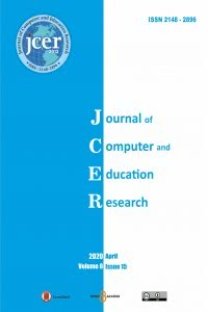A Case Study on Students’ Identity Perceptions Using Literary Sources in Reading Courses
Literature, ELT (English Language Teaching, Social context, Jane Austen
A Case Study on Students’ Identity Perceptions Using Literary Sources in Reading Courses
Literature, Jane Austen, ELT (English Language Teaching, Social context,
___
- Akarsu, O. & Darıyemez, T. (2014). The reading habits of university students studying English language and literature in the digital age. Journal of Language and Linguistics, 10(2), 85-99.
- Aksakal, E. (2015). A look at turkish nationalism in the light of modernist nationalistic theories. Atatürk Üniversitesi Edebiyat Fakültesi Sosyal Bilimler Dergisi, 54, 203-222.
- Cheng, H. W. (2012). Semantic and phonological activation in first and second language reading. USA: ProQuest LLC.
- Creswell, J. W. (2012). Planning, conducting and evaluating quantitative and qualitative research. Boston: Pearson Education.
- Ghosn, I. K. (2002). Four good reasons to use literature in primary school ELT. ELT Journal, 56(2), 172-179. https://doi.org/10.1093/elt/56.2.172
- Hanley, R. (2016). Slavery and the birth of working-class racism in England, 1814–1833. Transactions of the RHS, 26, 103–123.
- Kaya, H. İ., Han, T., & Aybirdi, N. (2015). Prospective EFL teachers’ attitudes towards the use of authentic materials in EFL reading classes. The Journal of International Social Research, 8(37), 773-783.
- Kaysili, A., & Acar-Erdol, T. (2014). The formation and development of nationalism and its continuation style through oppositions in Turkish nationalist university students. Journal of World of Turks, 6(3), 203-227.
- Keshavarzi, A. (2012). Use of literature in teaching English. Procedia - Social and Behavioral Sciences, 46, 554-559. https://doi.org/10.1016/j.sbspro.2012.05.159
- Khatib, M., Rezaei S., & Derakhshan A. (2011). Literature in EFL/ESL classroom. English Language Teaching, 4(1), 201-208. http://doi.org/10.5539/elt.v4n1p201 Rodliyah, R. S., Imperiani, E. D., & Amalia, L. L. (2014). Indonesian tertiary students’ attitudes towards the use of local culture vs target culture reading materials in English reading class. Bahasa & Sastra, 14(1), 109-120.
- Roozafzai, Z. S. (2012). The role of comic reading materials in enhancing the ability to read in EFL. I-Manager’s Journal on English Language Teaching, 2(3), 7-15.
- Shanahan, D. (1997). Articulating the relationship between language, literature and culture: Toward a new agenda for foreign language teaching and research. The Modern Language Journal, 81(2), 164-174.
- Tasneen, W. (2010). Literary texts in the language classroom: A study of teachers’ and students’ views at international school in Bangkok. Asian EFL Journal, 12(4), 173-187.
- Tavsanli, Ö. F. & Kaldırım, A. (2017). Examining the reading habits, interests, tendencies of the students studying at the faculty of education and analyzing the underlying reason behind their preferences. European Journal of Educational Research, 6(2), 145-156.
- Uyanıker, P. (2017). The possible effects of combined reading activities on the development of silent reading rate. Journal of Computer and Education Research, 5(9), 74-83.
- Uzer, U. (2016). An intellectual history of turkish nationality. Salt Lake City: The University of Utah Press.
- Yavuz, E. (2012). The evaluation of class distinction and moral values in Emma in language and culture studies. Atatürk Üniversitesi Edebiyat Fakültesi Sosyal Bilimler Dergisi, 12(49), 1-13.
- Yayın Aralığı: 2
- Başlangıç: 2013
- Yayıncı: Tamer KUTLUCA
An Examination of Middle School 7th Grade Students’ Mathematical Abstraction Processes
Elif KILIÇOĞLU, Abdullah KAPLAN
The Scale of Happiness Strategies for Children’s used by Preschool Teachers
Özkan SAPSAĞLAM, Ali ERYILMAZ, Ayça Bahar BAKKALOĞLU
Ortaya Çıkan Modelleme Yaklaşımıyla Kavramlaştırma Süreci: Sembolleştirme Örneği
Mathematics Teachers’ Views on Mathematical Thinking
Emine Nur ÜNVEREN BİLGİÇ, Ayşe Zeynep AZAK
Matematik Öğretmen Adaylarının, Matematik Etkinliklerindeki Sanata Yönelik Metaforik Algıları
Ebru KÜKEY, Hilal KÜKEY, Tayfun TUTAK
Teknoloji Destekli Probleme Dayalı Öğretim Uygulamalarının Matematik Başarısına Etkisi
Yücel ÇETİN, Şeref MİRASYEDİOĞLU
A Case Study on Students’ Identity Perceptions Using Literary Sources in Reading Courses
Yıldırım ÖZSEVGEÇ, Volkan MUTLU
Phenomenon-Based Learning for Teaching ICT Subject through other Subjects in Primary Schools
Karzan WAKIL, Rupak RAHMAN, Dana HASAN, Pakhshan MAHMOOD, Trifa JALAL
